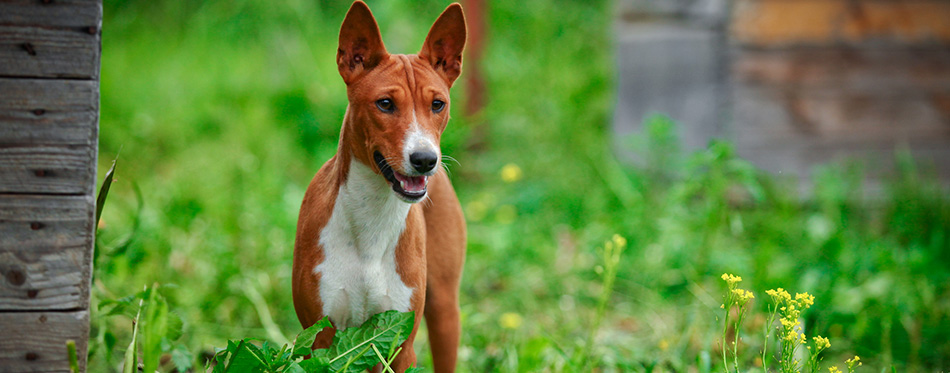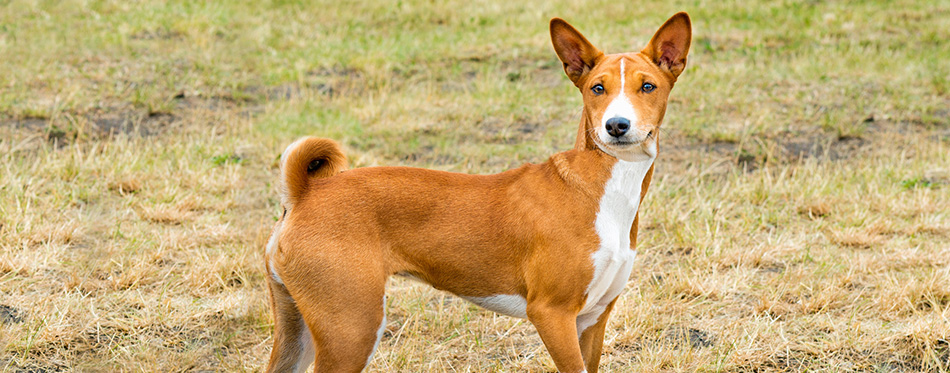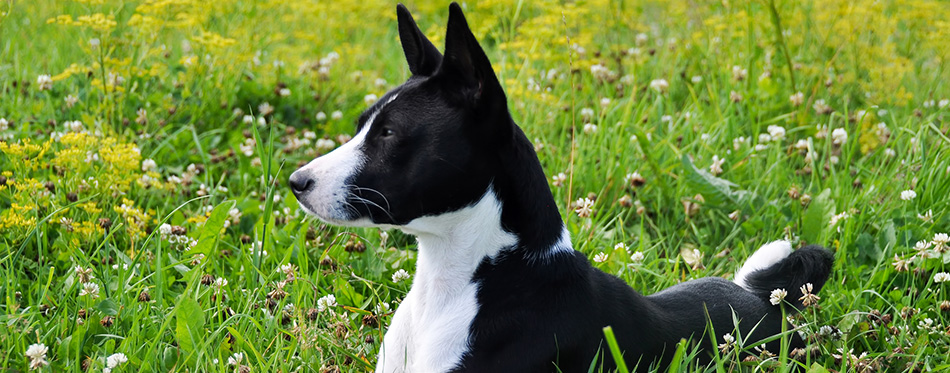The Basenji is an African dog that has qualities that even devoted cat persons will adore. This is a breed that is both smart and full of fun, often bordering on mischief. Its sense of independence is almost unparalleled in the dog kingdom. The Basenji has a sweet face that can endear it to anyone who sees it for the first time. Be forewarned, however, that this is a breed that’s very challenging to train.

History of the Basenji
You might not believe it but the Basenji is one of the oldest canine breeds on the planet. There are ancient Libyan cave paintings that archeologists dated to about 8,000 years ago. The cave paintings depicted hunters and their dogs. The dogs have curled tails. This is one of the most striking physical characteristics of the Basenji. There are also ancient Egyptian, Mesopotamian, and Babylonian artifacts that depict Basenji-looking dogs.
Basenjis thrived in the headwaters of the mighty Nile as well as the Congo River. Tribesmen prized these dogs for their explosive speed, hound-like sense of smell, and Saluki-like eyesight. Like many dogs native to the African continent, the Basenji lived unaltered by Western fancies and fads. As such, the very same dogs that Egyptian pharaohs and other ancient nobility welcomed as gifts are the same dogs we have today.
It was only in the 19th century when the very first Basenjis began “migrating” out of Africa. A returning English explorer brought several Basenjis with him to the UK in 1895. Unfortunately, there was a distemper epidemic at the time, killing the dogs as well as thousands of other dogs.
With the development of the distemper vaccine in the early parts of the 20th century, other British folks tried to import the breed. In 1923, Lady Helen Nutting was able to bring in 6 Basenjis from Sudan. Unfortunately, all six died from the same vaccine that was supposed to protect them against distemper.
The Basenji made a more successful comeback in the British Isles in 1937. The dog became an instant hit among the English dog-loving public. Unfortunately, the popularity of the Basenji was short-lived. Tragedy struck as the female Basenji and its puppies died. What was left was Bois, the male Basenji.
A Boston breeder – Henry Trefflich – was able to acquire Bois and mated it to his female Basenji, named Congo. This started the breeding of the Basenji in the US. Additional Basenjis were included in the gene pool to help strengthen the breed in the US.
By 1943, the American Kennel Club recognized the Basenji as a breed, belonging to the Hound Group. Basenjis are also recognized as a breed by the Federation Cynologique Internationale, the Australian National Kennel Council, the Kennel Club of UK, the Canadian Kennel Club, the United Kennel Club, and the New Zealand Kennel Club.
Quick Facts about the Basenji
Most people think they have what it takes to be the pet parent of this pariah breed. Before you decide, learn more about the Basenji.
- Small but Compact
The Basenji is a small dog, not taller than 17 inches for males and 16 inches for females. On the average, male Basenjis tip the scale at about 24 lbs, while females come in at 21 lbs. While these anthropometric measurements are in the lower end of the scale, its body frame tells otherwise. This is a dog with a small yet very muscular frame. It has well-developed muscles that look more like a thoroughbred. The breed has an athletic physique. This is a breed that packs a powerful punch in its small frame.
- Basenjis Don’t Bark
One of the signature characteristics of the breed is that they don’t bark, in the usual sense of the word. They do produce a very unique vocalization known as “baroo”. The closest sound that you can associate this with is the yodel. It does not have to learn how to yodel, though. The unusual shape of its voice box gives the breed the unique ability to produce the yodel-like sound. As such, people often call the breed the “barkless dog”.
There is a very good reason why Mother Nature gave the Basenji this remarkable talent. Its people believe that Basenjis do not bark to help conceal the actual location of its people. If it barks like a normal dog, its vocalization will lead its enemies to the encampments of its humans. When it yodels, predators and human intruders alike will think that it is a wild animal making the sound and not a dog.
- The Inspiration of an Egyptian God
Relics of ancient Egyptian culture depict Basenji-like dogs. The current consensus is that traders transported some of these pariah dogs from Central Africa to Egypt. They were given to pharaohs as gifts. The belief is that the Basenji served as an inspiration for Anubis, the Egyptian God of death, afterlife, and the Underworld. Anubis is always depicted as an Egyptian with a canine head. The head of Anubis has a very strong resemblance to the head of the Basenji, including its erect triangular ears and slender muzzle.
- Formidable Hunters
Don’t underestimate the size of the Basenji. This is like a Beagle that may be small but has the heart and the courage of a true hunter. What makes the Basenji a very unique hunter is that it uses both its senses of sight and smell when hunting. As such, it is both a scenthound and a sighthound. It is like combining the hunting prowess of a Saluki and a Bloodhound to track its prey. But what the Basenji is good at is in flushing its prey out of its den or hideaway. They can work in packs, too. In Africa, hunters employ at least four Basenjis to flush out a lion from its den. Once the big cat is out, human hunters can go in to finish the job.
- They Run like Greyhounds
How can a dog with small legs run like the long-legged and streamlined Greyhound, you ask? The secret is in the dog’s ability to perform what’s called the double suspension gallop. When dogs run, at least one of their paws is on the ground every time. The Basenji, like the Whippet and Greyhound, runs like a stallion in the wild. Greyhounds can reach up to 45 MPH, while Whippets can do it in 36. The Basenji is not far behind. It can run at a top speed of 35 MPH.
- They Do Not have Body Odor
Dogs always have a very distinct odor to them that can turn nasty when wet. The Basenji, on the other hand, does not emit that characteristic dog odor. It is a trait that it shares with the Australian Dingo. This is welcome news for potential pet parents who dislike having to smell their dogs. Head over to our review of pet odor neutralizer for more alternatives.
- Fastidious Groomers like Cats
One of the reasons why the Basenji doesn’t have that familiar dog odor is that it is as fastidious as a cat. It grooms itself almost on a constant basis. It will lick its paws and coat in an effort to keep it clean. Grooming it is a breeze, since the dog already does it itself. The Basenji has another cat-like trait. It is very independent. It only bonds with a specific member of its human family. It is also very challenging to train.

Things You Should Know
If you like to bring home a dog with cat-like qualities, then the Basenji is right for you. However, there are still a number of things that you have to understand before you start the process of getting one.
Health
One of the most common diseases that can afflict a Basenji is Fanconi syndrome. This is a hereditary disorder that results in the failure of the kidneys to reabsorb nutrients and electrolytes. It often presents when the dog is about 4 to 8 years old. Some of the manifestations are excessive urination, excessive drinking, and the presence of glucose in the Basenji’s urine. In effect, it mimics the symptoms of diabetes. As such, veterinarians should be very careful in making a diagnosis.
Other health issues that are quite common to the Basenji include hip dysplasia, immunoproliferative enteropathy, progressive retinal atrophy, bladder infection, hypothyroidism, and dermatitis. Some Basenjis can also carry a recessive gene that can produce genetic hemolytic anemia.
In general, Basenjis are healthy. They can reach a ripe age of 14 years, with the average at 13.6 years.
Feeding
Basenjis require a complete and well-balanced nutrition like any other dog breed. Proteins are essential to help in the optimal development of the dog’s muscles and other organs. Feeding it raw food is best, although this can be tricky without veterinary guidance. As such, giving it wet dog food with high-quality animal protein-first ingredients can provide the dog with the kind of nutrition that it needs.
One has to learn how to compute the dog’s daily energy requirements and not rely on what dog food manufacturers recommend. There are online resources that can help pet parents calculate their dog’s energy requirements by considering other factors such as activity level, life stage, and others.
For more guides on choosing the right dog food, you may wish to check out our reviews of the best dry dog food, organic dog food, grain free dog food, vegan dog treats and high protein dog food.
Care
Fanconi syndrome is a hereditary disease that is very common among Basenjis. What is sad is that many dogs get misdiagnosed with diabetes because of the uncanny similarities in the signs and symptoms. There are now DNA tests that can help determine the presence of a genetic marker for the disease. Having your Basenji DNA tested can help ascertain whether the dog is susceptible to such a health condition or not. If you are looking for more options, check out our guide on DNA tests for dogs.
Exercise remains a very important aspect in the Basenji’s care. This is a hunter that thrives on a lot of outdoor activities. While it is true that it has a very independent nature, providing it ample opportunities to walk, run, and play can help provide the necessary exercises for the dog.
Socializing the Basenji puppy is a must if one wants to temper its reserved attitude towards strangers. However, keep in mind that this dog has a high prey drive. No amount of socialization will save your small pets from the predatory instincts of the Basenji.
Regular veterinary visits are also important. From wellness examinations to routine vaccinations and preventative treatments, your veterinarian can help establish whether the Basenji is at its peak of health or not.
Grooming
Because of its fastidious cat-like behavior, there are no issues grooming the Basenji. You can still assist it by brushing its coat once a week to redistribute the skin oils and to remove dead hairs. This dog doesn’t need a bath, too; at least not very frequently. Brush its teeth every week. Clean its ears and trim its nails as often as necessary.
For more help on dog grooming, you may wish to read our guides on the best dog nail grinders, dog dryers, dog clippers, dog paw washers and dog shampoo.

Temperament
Basenjis have an endearing look. Underneath this cute and adorable façade, however, is a dog that is full of mischief, destructiveness, and cunning. It is an intelligent breed but this is often put to waste by its independent-mindedness. You can try to train it all day long but it may not listen to you. This is why some people say the Basenji is the second least intelligent dog breed in the world. Mind you, this is a smart breed. It just doesn’t see the need for training.
The breed has a very curious nature bordering on playfulness. Some say it loves to please its human companions. This is not always the case, though. It may give you the impression of playfulness but it is already thinking about getting its curiosity sated. Its curious nature is what often gets it into trouble. You’ve got to have the patience to live with a Basenji.
On the positive side of things, the Basenji makes a great watchdog. It is alert although not an obnoxious barker. Unfortunately, the reaction of a Basenji is as unpredictable as its temperament. Some may be aloof towards strangers while others may intimidate intruders by growling. Still, other Basenjis may not care at all.
Basenjis have a very wicked sense of humor and a beguiling personality. They are perfect for homes that can display lots of patience and can appreciate the dog’s mischievous personality. In other words, the Basenji is not for very sensitive folks.
Source:
- Introducing Basenjis – Basenji Club of America

